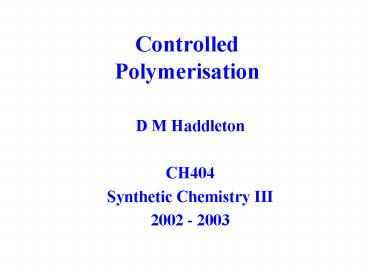Controlled Polymerisation PowerPoint PPT Presentation
1 / 67
Title: Controlled Polymerisation
1
Controlled Polymerisation
- D M Haddleton
- CH404
- Synthetic Chemistry III
- 2002 - 2003
2
Course Structure
- Introduction/Living Polymerisation
- Nitroxide Mediated Radical Polymerisation NMRP
- RAFT
- Transition Metal Mediated Radical Polymerisation
- Catalytic Chain Transfer Polymerisation
- Case Studies
3
Lecture Plan
- Introduction
- RAFT (Reversible Addition Fragmentation Transfer)
- ATRP, Transition Metal Mediated Polymerisation
- Catalytic Chain Transfer Polymerisation (CCTP)
- Case Studies
4
Task between Lectures
- 5 People involved in the chemistry
- 5 Companies
- 5 Potential Applications
- Major Limitation
- The best Paper in the area
5
Week 10 topics
- Light emitting polymers
- Why are IBM Leaders in Living Radical
Polymerisation? - Glycopolymers
- Polymers used in therapeutics
6
Essay title
- Compare and contrast living radical
polymerisation methods from an experimental point
of view.
7
Polymers in everday use
- Mechanical properties
- New applications
- Personal care products
- Pharmaceutical Applications
- BASF, Unilever, Geltex, Avecia, etc
8
Control over Polymer architecture
- Graft Copolymers
- Star copolymers
- Dendrimers
- Non covalent crosslinking
- Branching
- Narrow MWD
- Blocks
9
Control
10
Control of Macromolecular Structure
? Topology
? Composition
11
Innovations to Control RP
- Reversible homolytic cleavage
- Nitroxide-Mediated LRP (CSIRO, Georges, Fukuda,
Hawker,...) - Transition Metal Mediated LRP (ODriscoll,
Wayland, Sawamoto, Matyjaszewski, Percec,
Haddleton,...) - Chain transfer processes
- Addition Fragmentation (CSIRO)
- RAFT (CSIRO)
- Catalytic Chain Transfer Polymerisation (Smirnov,
Gridnev, Hawthorne, Janowicz, CSIRO, Haddleton,
Davis,...) - Combination of both
- Iniferters (Otsu)
12
Living Polymerisation
- Rate of termination ? 0
- Rate of Initiation gt Rate of Propagation
- Then
- PDi (Mw/Mn) 1 1/DP
13
Test for Living Polymerisation
14
Living Polymerisation
- Anionic
- Cationic
- Ring Opening
15
(No Transcript)
16
(No Transcript)
17
(No Transcript)
18
(No Transcript)
19
Commercial impact of living/controlled
polymerisation
- Anionic Polymerisation is the most established
form of living polymerisation - Although discovered in 1956 commercial
applications have probably not lived up to
expectations - Notable exception is styrene-diene block/star
copolymers (Kraton rubbers) - Generally anionic polymerisation requires low
temperatures, solvents which do not chain
transfer and extremely pure solvents and reagents.
20
Group Transfer Polymerisation
21
(No Transcript)
22
(No Transcript)
23
Free Radical Polymerisation
24
Nitroxide Mediated Radical Polymerisation
25
Reversible Homolytic Dissociation
- Covalent adduct
- Persistent radical
26
Acc. Chem. Res., 30 (9), 373 -382, 1997
27
Variation in experimentally determined molecular
weight, Mn, and the theoretical molecular
weights for thepolymerization of styrene at 125 C
using varying amounts of the unimolecular
initiator 9.
28
CRP of Styrene in Bulk
- T 393 K
- L0 5 10-2 M
29
Library of alkoxyamine structures evaluated as
initiators for the living free radical
polymerization of styrene and n-butyl acrylate.
30
TEMPO
31
Living Polymerisation of Dienes
32
(No Transcript)
33
Reversible Addition Fragmentation Polymerisation
- RAFT
34
RAFT Polymerisation
35
Macromolecules, ASAP Article 10.1021/ma991451a
S0024-9297(99)01451-5 Web Release Date January
6, 2000
36
GPC traces of (a) PMA prepared using 5 and (b)
the same PMA treated with ethylenediamine in THF
at room temperature
37
Generalized Addition-Fragmentation
38
Addition - Fragmentation
39
Atom TransferPolymerisation
40
(No Transcript)
41
(No Transcript)
42
K. Matyjaszewski Macromolecules 1997, 30, p7697
7042 7034 7348 8161 7692 6507, 6513, 6398
JACS 1997, 119, p674 V Percec Macromolecules
1997, 30, p6705, 8526 M Sawamoto Macromolecules
1997, 30, p2244, 2249 Teyssie Macromolecules
1997, 30, p7631, Haddleton Macromolecules 1997,
30, p2190
43
Macromolecules, 30 (25), 7697 -7700, 1997.
44
Macromolecules, 31 (4), 1064 -1069, 1998
45
(No Transcript)
46
Macromolecules, 31 (20), 6762 -6768, 1998
Jiro Ueda, Masami Kamigaito, and Mitsuo Sawamoto
47
Macromolecules, 31 (20), 6756 -6761, 1998
Hiroko Uegaki, Yuzo Kotani, Masami Kamigaito,
and Mitsuo Sawamoto
48
Macromolecules, 32 (7), 2204 -2209, 1999
49
(No Transcript)
50
Reaction rate dependence on the Cu(I)
51
Too much catalyst leads to problems of cost
and residual metal in products. Rate can be
accelerated Reduction of copper(II) to
copper(I) e.g. disproportionation with
copper(0) - Matyjaszewski Addition of rate
enhancers e.g. acid, alcohols Use of mildly
co-ordinated solvents However, for many
applications we require Much lower levels of
metal Recycling of metal Acceptable rates of
polymerisation
52
(No Transcript)
53
Synthesis of Initiators from alcohols
54
?- Functional polymers from functional initiators
based on phenols
55
Catalytic Chain Transferfor Molecular Weight
Control inFree-Radical Polymerisation
56
Measurement of Chain Transfer Constants
57
Polymerisation of MMA at 60 C with COBF
58
Types of Catalysts
59
Mechanism of CCTP
60
CCT Agents
61
Acrylate Monomers
62
Comparison of Catalysts
63
Generalized Addition-Fragmentation
64
Addition - Fragmentation
65
(No Transcript)
66
Further reaction of CCTP macromonomer products
67
(No Transcript)

